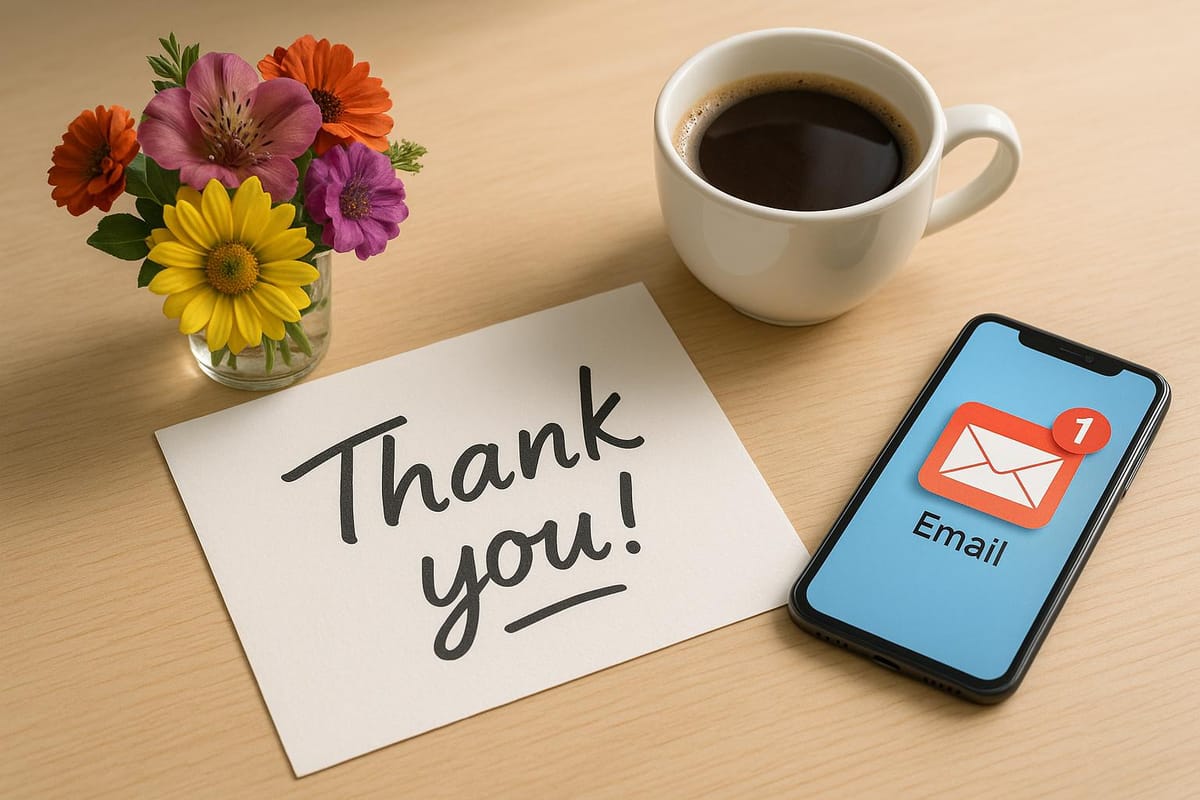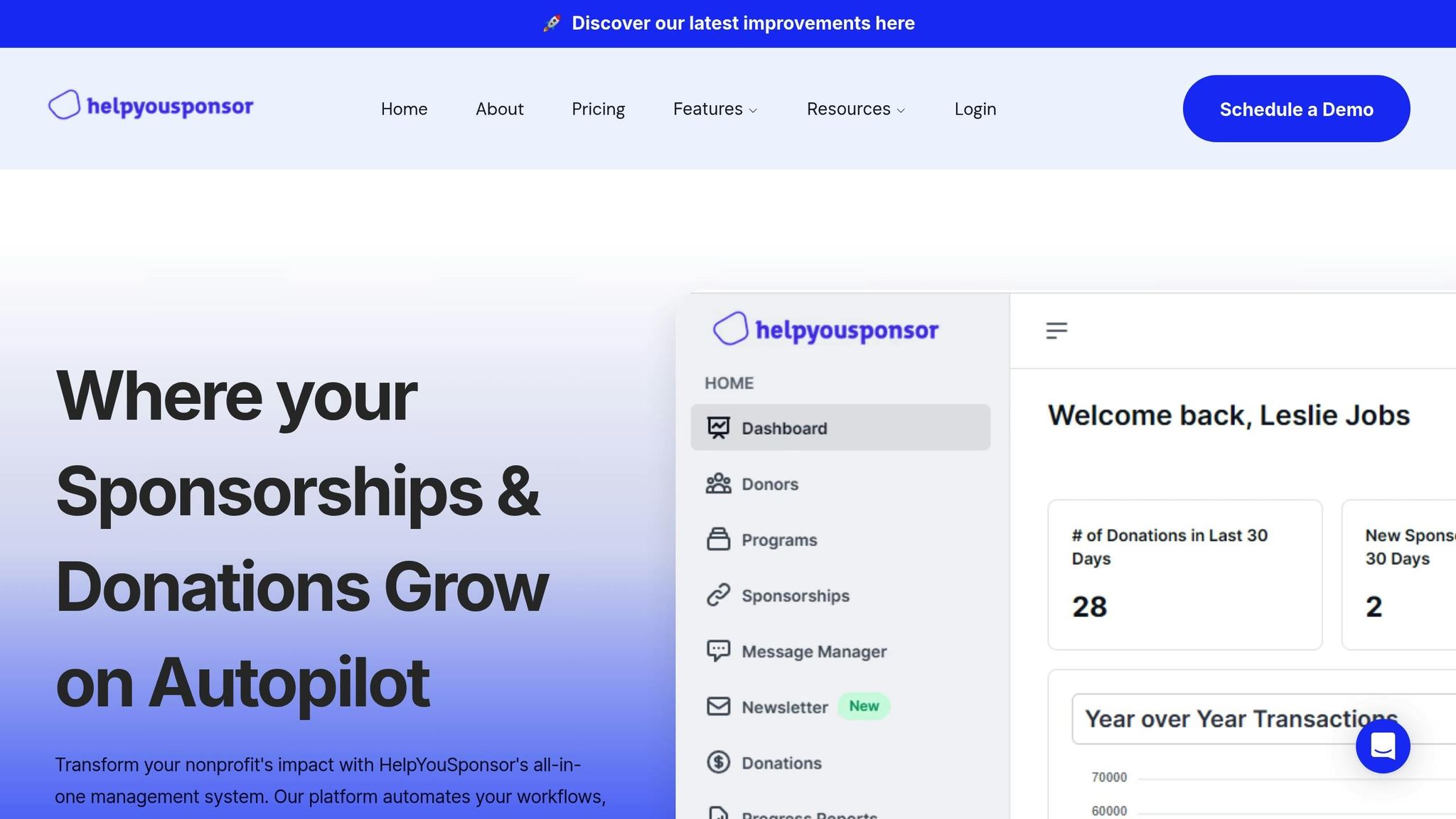Personalized Donor Messages: Why They Matter
Personalized donor messages enhance engagement and loyalty, making nonprofits more effective at building lasting relationships with supporters.

Personalized donor messages are a game-changer for nonprofits. They build stronger connections, boost engagement, and increase donor loyalty by tailoring communication to each supporter’s interests and history. Studies show that these messages outperform generic ones, leading to higher open rates, more donations, and better retention.
Key Takeaways:
- What they are: Messages tailored to individual donors based on their past contributions, interests, and preferences.
- Why they work: They make donors feel seen and appreciated, leveraging psychological principles like reciprocity and emotional connection.
- Proven results: Higher response rates, increased giving, and long-term donor relationships.
- How to implement: Use donor segmentation, technology like automation and dynamic content, and personal touches like handwritten notes or phone calls.
- Data management: Keep donor data accurate, respect communication preferences, and comply with privacy laws like CAN-SPAM and TCPA.
Personalization isn’t just a nice-to-have - it's a proven way to retain donors and maximize impact. Let’s explore how it works and how you can start using it today.
Personalized Donor Communication: The Ultimate Guide
Research Evidence: Impact on Donor Engagement and Retention
Studies reveal that personalized communication has a powerful effect on donor engagement, contributions, and loyalty. By crafting messages that align with each donor's unique history and interests, organizations have seen noticeable improvements in how donors respond, how much they give, and how long they stay connected. Below, we’ll dive into the key findings and psychological principles explaining why this approach works so well.
Key Findings on Donor Engagement
Research highlights that personalized messaging - like using a donor’s name in subject lines or referencing their past contributions - can significantly boost engagement. Messages that feel tailored to the individual often lead to higher open rates, more clicks, and, most importantly, an increase in repeat donations. When donors feel seen and valued, they’re far more likely to stay involved.
The Psychology Behind Personalization
Why does personalization work? It taps into some well-established psychological principles. One is the identifiable victim effect, which shows that people are more inclined to help when they connect with a specific individual rather than a general cause. On top of that, acknowledging a donor’s previous contributions fosters a sense of reciprocity and reinforces their value to the organization. This emotional connection not only encourages immediate giving but also strengthens loyalty over time.
Personalized vs. Generic Communication Results
While exact numbers aren’t provided here, the pattern is undeniable: messages that feel personal consistently outperform generic ones. They enhance both short-term engagement and long-term donor retention, creating a solid foundation for sustainable fundraising efforts.
Effective Personalization Strategies for Donor Communication
Now that we've covered why personalized messages resonate so well, let’s dive into strategies your organization can use to create deeper connections with donors. These methods range from simple segmentation to leveraging advanced automation tools.
Donor Segmentation and Targeting
At the heart of effective personalization is understanding your donors - what drives them and how they engage with your mission. Donor segmentation involves grouping supporters based on shared traits, behaviors, or interests, making it easier to tailor messages that speak directly to them.
Start with demographic segmentation. Different age groups and locations often prefer distinct communication styles. For example, younger donors might respond better to text messages and social media updates, while older supporters may appreciate traditional mail or phone calls.
Next, look at giving history segmentation. First-time donors need warm welcome messages that introduce your mission and showcase your impact. Monthly donors deserve regular updates on ongoing projects they’re helping to fund, along with recognition for their steady support. Major gift donors, on the other hand, often require detailed reports and personal attention from leadership.
For a deeper level of personalization, use interest-based segmentation. If your organization supports multiple programs - like education, healthcare, or community development - tailor updates to match donors’ passions. For instance, someone who consistently supports education initiatives would likely appreciate stories about student successes or updates on school projects, while healthcare-focused donors might prefer hearing about medical advancements or facility improvements.
Donor profiles are key to making this work. Keep track of donation amounts, dates, preferences, and even volunteer history. This data lays the groundwork for all your personalized communications.
Using Technology for Personalization
Technology takes segmentation to the next level, enabling personalized outreach on a much larger scale. Merge fields are a good starting point - these let you automatically insert donor-specific details like names, donation amounts, or giving history into emails and letters.
For a more advanced approach, consider automated donor journeys. These systems trigger specific message sequences based on donor actions or characteristics. For example, first-time donors could be enrolled in a welcome series that introduces your work over a few weeks. Annual donors might receive a recognition sequence around their giving anniversary, complete with impact reports showing how their contributions have made a difference.
Dynamic content is another powerful tool. With this feature, you can create a single email template that displays different content based on donor segments. This keeps your communications efficient while ensuring each donor receives messages relevant to their interests.
Behavioral triggers allow you to respond to specific actions. If someone visits your website’s monthly giving page but doesn’t complete a donation, you can send a follow-up email explaining the benefits of recurring support. Similarly, donors who haven’t contributed in a year could receive a “we miss you” message highlighting recent achievements they’ve helped make possible.
Platforms like HelpYouSponsor make these personalization features more accessible. With automated messaging capabilities, you can set up thank-you sequences, donation receipts, and follow-up communications that maintain a personal tone while scaling across large donor lists.
Balancing Automation with Personal Touch
While automation makes routine communications more efficient, adding a personal touch is what truly strengthens donor relationships. The best strategies combine the speed of automation with the warmth of genuine human connection.
Handwritten notes are a simple yet impactful way to show appreciation, especially for major donors. A short, thoughtful thank-you card from a staff member or board director can leave a lasting impression.
Personal phone calls are another powerful tool. Reaching out for milestones - like giving anniversaries, major gifts, or a donor’s return after a long absence - can deepen relationships in ways that automated messages can’t. These calls don’t need to include donation requests; a heartfelt thank-you and a quick update on your organization’s impact can go a long way.
Video messages provide a middle ground between automation and personal interaction. A short thank-you video from a program beneficiary, staff member, or organizational leader creates a personal connection while remaining scalable. These videos can be embedded in emails or shared on social media to engage multiple donors at once.
Using data insights helps you decide when personal outreach is most effective. Automated systems can flag donors who might benefit from extra attention, such as those with reduced engagement, those nearing major giving levels, or those showing increased interest through website activity or event participation.
Finally, timing coordination ensures your automated and personal communications complement each other. For example, if a donor receives an automated thank-you email immediately after donating, a personal follow-up should come later with fresh content that builds on the initial message rather than repeating it.
These approaches lay the groundwork for efficient data management and compliance practices, which we’ll explore next.
Best Practices for Data Management and Compliance
Clean, well-organized data and adherence to legal standards are the backbone of effective donor communication. Personalizing donor interactions starts with reliable information, ensuring every message resonates on an individual level. These data management strategies align closely with the personalized approaches mentioned earlier.
Maintaining Accurate Donor Data
The quality of your data directly impacts your ability to personalize effectively. Mistakes like addressing donors incorrectly or misreporting donation details can harm relationships instead of building them.
To maintain accuracy, conduct regular data audits and assign data stewardship roles within your organization. Designate team members to oversee data entry, updates, and quality control, and establish clear procedures for managing donor information. During audits, look for duplicate records, outdated contact details, and inconsistencies in formatting.
Stay on top of contact preferences by routinely asking donors how they prefer to hear from you. Some may prefer email updates, while others might like postal mail or text messages. Keeping these preferences updated ensures your messages reach donors in ways they appreciate, reducing the risk of communication fatigue.
When it comes to donation tracking, record more than just amounts and dates. Include campaign sources, payment methods, and any special designations. This detailed information allows you to craft personalized messages that reflect donors' giving history and interests.
For new donors, implement data verification processes. After a first donation, send a confirmation email or letter that lists their contact information and invites them to correct any errors. This proactive step not only catches mistakes early but also shows donors you value accuracy.
Compliance with U.S. Privacy and Communication Laws
Accurate data isn’t just about personalization - it’s also critical for meeting legal requirements in the U.S.
The CAN-SPAM Act regulates email communications, including those from nonprofits. Every email must include your organization’s physical address, a clear unsubscribe option, and honest subject lines that reflect the content. You’re required to process unsubscribe requests within 10 business days, and you can’t charge fees or ask for more than an email address to opt out.
SMS and text messaging are subject to stricter rules under the Telephone Consumer Protection Act (TCPA). You must have explicit written consent before sending texts to donors. This consent should clearly outline the types of messages donors will receive and their frequency. Keep records of when and how consent was given, as the responsibility to prove compliance rests with your organization.
Ensure your opt-out mechanisms are simple and functional. Include unsubscribe links in every email and make sure they work seamlessly. For text messages, provide clear instructions like “Reply STOP to opt out,” and honor all opt-out requests immediately.
Your record retention policies should balance legal obligations with practical considerations. Keep donation records and tax receipts for at least seven years, but be more selective about retaining communication preferences and marketing data. Establish clear timelines for deleting inactive donor records, especially for those who haven’t engaged with your organization in years.
Using HelpYouSponsor for Data Management

Leveraging technology can simplify donor data management while ensuring compliance. HelpYouSponsor offers a centralized solution designed to streamline these processes.
With automated data consolidation, the platform unifies donation history, communication preferences, and engagement tracking in one place. This makes it easier to identify duplicate records, monitor donor journeys, and maintain consistent messaging. When a donor updates their contact information in one channel, the system automatically updates it across the board.
The platform’s built-in compliance tools take the guesswork out of legal requirements. It automatically includes unsubscribe options in emails and keeps records of consent for different communication types. These records can be crucial if you need to demonstrate compliance during an audit.
Automated receipts save time by generating tax documentation tailored to donation types, amounts, or donor segments. These receipts include all legally required language and organizational details, reducing administrative burdens.
HelpYouSponsor’s engagement tracking tools help you understand which donors are actively responding to your communications and which may need a different approach. This insight allows you to identify supporters who would benefit from personal outreach and flag those who might be disengaging, so you can adjust messaging frequency or content accordingly.
Finally, the platform’s reporting capabilities simplify data audits and compliance reviews. You can quickly identify donors who haven’t been contacted recently, track communication preferences, and generate reports for board meetings or regulatory needs.
Measuring Success and Improving Personalization Efforts
Keeping track of the right metrics can turn personalized donor communication into a powerful tool for building stronger connections and driving results.
Key Metrics for Evaluating Success
Open rates are a great starting point for gauging how well your messages are landing. On average, email campaigns hit about a 20% open rate, but text messages soar with a 99% open rate - making SMS an excellent choice for urgent or high-priority updates. To improve email open rates, try using subject lines that include the donor's name or reference their previous contributions. A strong, engaging opening line that hints at valuable content can also make a big difference.
Click-through rates (CTR) show whether your personalized content is inspiring action. Including clear calls to action and personal touches, like addressing donors by name or referencing their last donation, can significantly boost CTR. Tailor your messages by segmenting your audience based on factors like location, age, donation habits, or giving levels. This way, your content speaks directly to the interests and capacity of each group.
Donor retention rates are the ultimate measure of long-term success. While the average donor retention rate in 2022 was 42.6%, a staggering 70% of donors never give again after their first donation. Retaining donors is critical because those who stick around tend to contribute much more over time, making retention a more valuable focus than constant donor acquisition.
Average donation amounts help you track whether personalized communication is encouraging higher giving levels. Pair this data with suggested donation amounts and clear explanations of impact. When donors see exactly how their contributions make a difference, they’re often motivated to give more over time.
Unsubscribe rates can be a red flag for misaligned messaging. Keep your communications varied - mix in updates, event invitations, and volunteer opportunities. Promptly thank donors after they give, mentioning their specific donation amount and its impact. Adding visuals like photos, videos, or even emojis can help keep your audience engaged.
Tracking these metrics ties directly to the personalization strategies you’ve implemented, helping refine donor segmentation and communication approaches.
Using A/B Testing and Feedback
A/B testing takes the guesswork out of personalization. Experiment with specific elements like subject lines or the level of personalization to see what resonates. For instance, test whether mentioning a donor's last gift amount drives more responses than a general acknowledgment of their "generous support."
Timing tests can also yield valuable insights. Send identical personalized messages to similar donor groups at different times - morning, midday, or evening - and track open and click-through rates. Over time, you’ll identify patterns that reveal when your audience is most responsive.
Message format testing helps you understand your donors' preferences. Compare longer, story-driven emails with shorter, bullet-point updates. Some groups might favor a formal tone, while others respond better to casual, conversational language.
Direct feedback goes beyond the numbers. Add short surveys to your communications to learn about your donors' preferences for contact frequency and content. Keep these surveys brief - three questions or fewer - to encourage responses. For example, ask, "How often would you like to hear from us?" and offer clear options like weekly, monthly, or quarterly.
Post-donation surveys are especially effective because donor engagement is highest right after giving. Send these within 48 hours of a donation to thank the donor and ask one or two quick questions about their experience. This approach not only boosts response rates but also provides actionable insights for future campaigns.
These testing and feedback strategies allow you to fine-tune your approach, ensuring your messages stay relevant and engaging.
Continuous Improvement Through Data Insights
Regularly analyzing your data helps you spot trends and refine your strategy. Review key metrics monthly to identify patterns across different donor segments. For instance, if long-time supporters are less engaged, consider whether you’re over-communicating or if your messages feel repetitive.
Seasonal analysis can help you plan campaigns more effectively. Track which months see the most engagement and giving. While many nonprofits experience a surge in November and December, your organization’s patterns might differ depending on your mission and donor base.
Platforms like HelpYouSponsor simplify this process by tracking donor engagement automatically. These tools highlight which donors are actively responding and which might need a different approach. You can quickly generate reports to understand communication preferences, donation habits, and engagement trends.
Over time, predictive insights emerge from consistent data collection. For example, donors who stop opening emails or delay their usual giving schedule might benefit from more personalized outreach or a change in communication frequency.
Set up automated alerts to flag significant changes in key metrics. If your open rate drops by more than 10% in a month, investigate immediately. Similarly, if a major donor hasn’t engaged in a while, prompt your team to follow up with a personalized message.
Treat every communication as a chance to learn. Document what works for different donor segments and build a resource that guides future efforts. This systematic approach turns occasional wins into reliable strategies, strengthening your donor relationships over time.
Conclusion: Building Stronger Donor Relationships with Personalization
Studies show that personalized donor communication creates deeper emotional bonds and outperforms one-size-fits-all methods in driving donor engagement and loyalty.
Today’s technology makes personalization more accessible than ever for nonprofits. Tools like HelpYouSponsor allow organizations to segment their donor base, monitor engagement, and automate outreach - all while staying compliant with U.S. privacy regulations and maintaining a genuine, human connection. This mix of tech and authenticity forms the foundation for continuous improvement.
The key to success is treating personalization as an ongoing journey, not a one-and-done effort. Regular A/B testing and analyzing data help refine strategies to keep donors engaged over time.
FAQs
How can nonprofits combine automation with a personal touch in donor communication?
Nonprofits can find the sweet spot between automation and personalization by grouping donors based on factors like demographics, interests, and past giving patterns. This approach helps craft messages that resonate on a personal level, making donors feel valued and understood.
By using tools such as dynamic content and behavioral triggers, organizations can ensure their communication reaches donors at the right time and reflects their recent actions, all while keeping the tone personal. Incorporating AI for smarter targeting and predictions can also streamline efforts, allowing nonprofits to save time while still maintaining a human touch.
To nurture trust and build authentic relationships, nonprofits should focus on maintaining accurate donor data, begin with small-scale personalized initiatives, and mix automated messages with occasional heartfelt, direct outreach.
Why are personalized donor messages more effective than generic ones?
Personalized donor messages work wonders because they build a deeper emotional connection and show genuine appreciation. Using a donor’s name and pointing out the specific impact of their contribution makes them feel seen, valued, and directly tied to the cause they care about. This personal touch doesn’t just make them feel good - it strengthens their bond with your organization.
On top of that, personalized communication taps into the idea of reciprocity. When donors feel truly appreciated, they’re more inclined to keep supporting your mission. Tailored messages let them know their efforts make a real difference, which encourages continued involvement and future contributions.
How can nonprofits personalize donor communications while staying compliant with privacy laws?
To tailor donor communications while staying compliant with privacy laws, nonprofits need to adhere to regulations like the CCPA and GDPR. These laws emphasize being transparent about how donor data is used and obtaining explicit consent from donors. A good starting point is having a clear and easy-to-access privacy policy. Additionally, restrict access to donor data to only those team members who are authorized to handle it.
Protecting donor information requires secure data management practices. This includes using encryption, conducting regular audits, and ensuring staff is trained on privacy laws. Keeping policies updated to reflect any legal changes is equally important. Beyond compliance, these steps strengthen trust and foster lasting relationships with donors.

